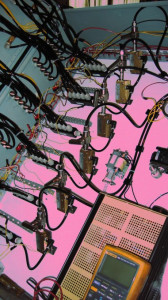Gas Leak Detection
Leak detection is serious business. Gas escaping from a piping system needs to be detected quickly. Depending on the type of gas, the consequences range from merely wasteful to fatal. Leaking gas can also be environmentally damaging, can create an explosion risk, and can even kill thousands of people, as happened in the Bhopal, India chemical plant disaster.
Finding Leaks
Technology for finding gas leaks falls under two headings:
- Detecting the presence of gas
- Leak sensing
Detecting the Presence of a Gas
This refers to methods that detect traces of a particular gas in the air. One example is the carbon monoxide detector found in many homes. The three primary detection technologies are electrochemical, semiconductor devices and infrared sensors.
Electrochemical gas detectors use a membrane covering an electrode. The membrane material is selected to allow through only the gas being monitored. When this gas reaches the electrode a reaction occurs that is measured electrically. In general, this type of gas detector has a fairly short life, needing replacement after one to two years.
Semiconductor sensors work in a similar way. The electrical resistivity of a material like tin dioxide varies depending on the gas it is in contact with. By setting an alarm at a certain level of resistance it’s possible to ‘tune’ the sensor for a specific gas.
Infrared sensors are split into point detectors and camera systems. Both work on the principle of infrared light absorption. Gases tend to absorb specific wavelengths, and this can be measured by shining infrared light through the air. Point gas detectors are useful for remote sensing. Camera systems employ the same principle but the images help with locating the source of a leak.
These gas detection sensors have several weaknesses:
- Must be configured for a specific type of gas
- May need frequent replacement
- Gas concentration must be sufficient to trigger an alarm
- The leak source may not be obvious
Leak Sensing
This refers to methods of actually finding leaks. Ultrasonic sensors are devices that emit an acoustic wave beyond the upper range of human hearing — called the audible range, between 20 hertz and 20 kilohertz – and determine the distance between the sensor and an object based on the time it takes to send the signal and receive the echo. Ultrasonic sensors have many applications, including: parking assistance sensors in cars, proximity alarms, medical ultrasounds, generic distance measurement, and commercial fish finders, among other applications. An ultrasonic sensor can be used to pin down the source of the leak.
An alternative method is to incorporate flow monitors into the equipment. Devices like the ChemTec 125 Series flow monitor employ a magnetic piston that floats in the gas stream. If the flow rate increases, (as happens when a leak reduces back pressure,) the piston moves higher. Sensors detect the movement and send an alarm signal when it exceeds a preset limit.
The 125 series of flow monitors also detect low-flow conditions. This means they can do double-duty, detecting blocked pipes or filters as well as leaks.
You Have Options
Gas leaks are a serious problem. Technologies exist to sense the presence of gas in air, but it’s also possible to detect when a leak is happening. Ultrasonic sensors will ‘hear’ the high frequency whistle of escaping gas, and flow monitors can send an alarm whenever an abnormal condition occurs.
Call our Ryan Herco Flow Solutions experts at 800-848-1141 if you have any questions about the ChemTec 125 Series flow monitors for leak detection.
